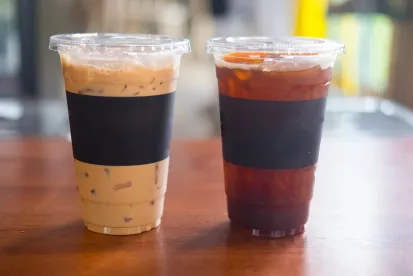On June 30, 2022, California Governor Gavin Newsom signed Senate Bill 54 (S.B. 54) or the Plastic Pollution Prevention and Packaging Producer Responsibility Act (the Act) into law. The Act establishes an aggressive extended producer responsibility (EPR) program for single-use plastic packaging and plastic single-use food service ware by requiring all covered material sold in or imported into California to be recyclable or compostable by 2032. The Act also requires a 25% reduction in the use of plastic packaging by 2032 and a 65% recycling rate of the remaining single-use plastic packaging by the same year. Although S.B. 54 seeks to promote plastic recycling, the legislative history intended to restrict the use of plastic recycling technologies, such as pyrolysis and gasification.
In order to fund development of the infrastructure needed to implement these ambitious goals, the Act requires Producer Responsibility Organizations (PROs) to remit a $500 million surcharge to the California Department of Tax and Fee Administration on an annual basis beginning in 2027. These funds will be deposited into the California Plastic Pollution Mitigation Fund, which is projected to amass over $5 billion over the next ten years based on the collection of surcharges, interest, penalties, and other collected amounts. As drafted, the compliance onus will be on brand owners who will likely shift the requirements upstream, but, as we discuss below, the Act will likely affect a much broader range of businesses.
What is Regulated?
S.B. 54 regulates two classes of “covered material,” including (a) single-use packaging that is routinely recycled, disposed of, or discarded after its contents have been used or unpackaged, and typically not refilled or otherwise reused by the producer; and (b) plastic single-use food service ware, including, but not limited to, plastic-coated paper or plastic-coated paperboard, paper or paperboard with plastic intentionally added during the manufacturing process, and multilayer flexible material.[1]
Single-use packaging encompassed by the definition of “covered material” includes a broad array of packaging for both food and non-food purposes unless exempted. Indeed, “packaging” includes “any separable and distinct material component used for the containment, protection, handling, delivery, or presentation of goods by the producer for the user or consumer, ranging from raw materials to processed goods.”[2] The term should be read broadly to apply to packaging components, sales or primary packaging, secondary packaging, and transport packaging used to protect products during transport.
Food service ware, on the other hand, will include (but is not limited to) plastic-coated paper or plastic-coated paperboard, paper or paperboard with plastic intentionally added during the manufacturing process, and multilayer flexible material. This category includes food trays, plates, bowls, clamshells, lids, cups, utensils, stirrers, hinged or lidded containers, and straws as well as wraps or wrappers and bags sold to food service establishments.[3]
Notably, the term “plastic” as used in the above definition, and throughout the Act, includes:
synthetic or semisynthetic material chemically synthesized by the polymerization of organic substances that can be shaped into various rigid and flexible forms, and includes coatings and adhesives.[4]
This definition includes polyethylene terephthalate (PET), high density polyethylene (HDPE), polyvinyl chloride (PVC), low density polyethylene (LDPE), polypropylene (PP), polystyrene (PS), polylactic acid (PLA), and aliphatic biopolyesters, such as polyhydroxyalkanoate (PHA) and polyhydroxybutyrate (PHB). However, natural rubber or naturally occurring polymers such as proteins or starches are not considered “plastics” for the purposes of the Act.[5]
Some plastic packaging used for products regulated or defined under other laws are exempted from the Act.[6] Exemptions include packaging for medical products and products defined as devices or prescription drugs by the Federal Food, Drug, and Cosmetic Act (FDCA); animal products regulated under the FDCA or the Federal Insecticide, Fungicide, and Rodenticide Act (FIFRA); infant formula and certain supplements; products regulated by FIFRA; certain dangerous or hazardous materials; beverage containers subject to the California Beverage Container Recycling and Litter Reduction Act; packaging for long-term storage of products determined by CalRecycle to have a lifespan of at least five years; and packaging associated with products covered under California’s Architectural Paint Recovery Program.
Who is Affected?
As with other EPR laws, S.B. 54 seeks to leverage business relationships to effectuate change throughout the supply chain. Thus, the law does not focus on packaging manufacturers but rather those companies that sell or distribute “products” using such packages in the state. Specifically, Section 42041(w)(1) defines a “producer” for purposes of the Act as:
…a person who manufactures a product that uses covered material and who owns or is the licensee of the brand or trademark under which the product is used in a commercial enterprise, sold, offered for sale, or distributed in the state.
If there is no person meeting this definition in California, then Section 42041(w)(2) defines a “producer” as:
…the owner or, if the owner is not in the state, the exclusive licensee of a brand or trademark under which the covered product using the covered material is used in a commercial enterprise, sold, offered for sale, or distributed in the state. For purposes of this subdivision, a licensee is a person holding the exclusive right to use a trademark or brand in the state in connection with the manufacture, sale, or distribution of the product packaged in or made from the covered material.
If no person meets either of the above definitions, then a “producer” is:
…the person who sells, offers for sale, or distributes the product that uses the covered material in or into the state.
In short, the Act will primarily affect those companies that put their product name and brand on the covered material, whether or not they have actually manufactured the plastic packaging. Otherwise, retailers or distributors will be obligated to comply. We anticipate, however, that the effects of this regulation will be felt throughout the supply chain as product manufacturers and/or brand owners incorporate S.B. 54 compliance in purchase agreements.
Requirements for Brand Owners
Brand owners importing, selling, or distributing products in California that are packaged in covered material must comply with several requirements. Specifically, they must ensure that:
-
The overall amount of plastic covered material, including the number of products packaged in covered material, in the state of California is source reduced by 10% by January 1, 2027, 20% by January 1, 2030, and 25% by January 1, 2032.[7] Methods of source reduction include, but are not limited to, shifting covered material to reusable or refillable packaging or a reusable product or eliminating unnecessary packaging.[8]
-
All covered material is recyclable or compostable within the state by January 1, 2032.[9] As defined by the Act, “recycling” involves the process of collecting, sorting, cleansing, treating, and reconstituting materials that would otherwise be disposed of and returning them to the economic mainstream in the form of recovered material for new, reused, or reconstituted products, including compost.[10] Recycling does not, however, include combustion, incineration, energy generation, fuel production (with limited exception), or other forms of disposal.[11] CalRecycle is expected to expand upon this list of exclusions in the forthcoming regulations, which must establish criteria to exclude plastic recycling technologies that produce significant amounts of hazardous waste from the definition of “recycling.”[12] According to the legislative history, the definition is “intended to exclude technologies, such as gasification, pyrolysis, and solvent-based technologies,” and thus, poses significant concerns for chemical recycling solutions that are often used to recover valuable feedstocks from mixed plastic streams.[13]
-
Plastic covered material offered for sale, distributed, or imported in or into California meets specified recycling rates of 30% by January 1, 2028, 40% by January 1, 2030, and 65% by January 1, 2032.[14] A separate schedule is established for expanded polystyrene (EPS), which prohibits any producer from selling, offering for sale, distributing, or importing EPS food service ware into California unless it is recycled at a rate of 25% by January 1, 2025, 30% by January 1, 2028, 50% by January 1, 2030, and 65% by January 1, 2032.[15]
Producer Responsibility Organizations
All producers of covered material (as noted above, “producers” are the manufacturers of products that use covered materials) must form and join a PRO by January 1, 2024. Once the PRO plan is approved, or no later than January 1, 2027, producers will be prohibited from selling, offering for sale, importing, or distributing covered materials in California unless the producer is approved to participate in a PRO’s plan. Producers may be exempt from participating in a PRO’s plan if they assume individual responsibility and liability for compliance with the Act and demonstrate a recycling rate of 65% for three consecutive years before 2027 and 70% thereafter.[16] As with S.B. 343, the state is effectively requiring that manufacturers have in place a take-back program with a recycling rate of 65% in order to be exempt. Except for toner manufacturers, we are not aware of individual programs achieving such rates. If a producer is unable to meet these recycling rates, it may also be exempted if it meets each of the following requirements:
-
From the 2013 calendar year to the 2022 calendar year, inclusive, the producer achieved a net 5 percent or greater source reduction of its covered materials through shifting to refill, reuse, or elimination.
-
From the 2013 calendar year to the 2022 calendar year, inclusive, the producer achieved a net 8 percent or greater source reduction of its covered materials through optimization, concentration, right-sizing, bulking, shifting to a nonplastic packaging, or lightweighting, or increasing the number of consumer uses.
-
Seventy-five percent of the producer’s covered material sold, offered for sale, distributed, or imported into the state is in a covered material category that meets a 30-percent recycling rate as of January 1, 2023.[17]
PROs will collect fees from member producers based on a fee schedule to be developed by the PRO pursuant to Section 42053(c).[18] This schedule is to be developed as a part of the PRO plan and must be sufficient to ensure the requirements of this chapter, such as the $500 million remittance, are met and that the PRO budget is fully funded. The initial schedule must be based on the estimated costs of implementing the plan, operation, completing the needs assessment, reimbursing the department, and costs to cover the environmental mitigation surcharges.[19] Notably, in addition to the fees collected from member producers, the PRO may also collect up to $150 million from plastic resin manufacturers that sell plastic covered material to member producers.[20]
Penalties assessed under S.B. 54 will also be deposited in the state Plastic Pollution Mitigation Fund. Penalties will be costly for producers as CalRecycle is authorized to assess penalties of up to $50,000 per day per violation of the Act.
* We would like to acknowledge Summer Associate, Catarina Conran, who assisted in drafting this article.
FOOTNOTES
[1] Cal. Pub. Res. Code § 42041(e)(1)
[2] Id. at § 42041(s).
[3] Id. at § 42041(e)(1)(B)(i)-(ii).
[4] Id. at § 42401(t).
[5] Id.
[6] Id. at § 42041(e)(2)(A).
[7] Id. at § 42050(a). The California Department of Resources Recycling and Recovery (CalRecycle) has the authority under the Act to increase these required percentage reductions of plastic covered material under certain conditions and will conduct evaluations every five years, beginning in 2030, to determine whether such increase is necessary (i.e., if the amount of plastic in the economy and waste stream increases). Id. at § 42057(h).
[8] Id. at § 42041(aj).
[9] Id. at § 42050(b).
[10] Recycled products must meet the quality standards necessary to be used in the marketplace. Id. at § 42041(aa)(1).
[11] Id. at § 42041(aa)(2).
[12] Id. at § 42041(aa)(5); Assembly Floor Analysis, S.B. 54 (June 26, 2022) at 4.
[13] Assembly Floor Analysis, S.B. 54 (June 26, 2022) at 4-5.
[14] Cal. Pub. Res. Code § 42050(c).
[15] Id. at § 42057(i).
[16] Id. at § 42051(b)(2)(A).
[17] Cal. Pub. Res. Code § 42051(b)(2)(A)(i)-(iii).
[18] Id. at § 42053.
[19] In the third year of the PRO plan, and each successive year after that, producers will pay an annual fee as established in the PRO plan based on factors such as the cost to develop and sustain viable end markets for each category of covered material and costs associated with collecting, sorting, removing contamination from, aggregating, and transporting the covered material. See id. at §§ 42053(b) and (d).
[20] Id. at 42064(e)(3). This provision raises significant questions about the basis under which PROs could collect fees from resin manufacturers and the state’s authority to authorize such collection. Tracing resin used in a package back to a particular manufacturer, let alone proving that the resin is used in specific covered material, will likely prove quite difficult given the number of actors involved between resin production and packaging of a product. Such tracing will be even more difficult for covered materials sourced outside of California or the United States.





 />i
/>i

